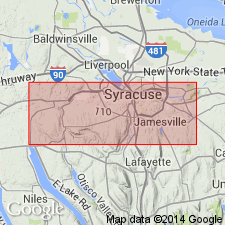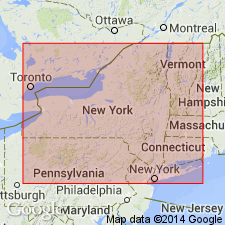
- Usage in publication:
-
- Bishop Brook limestone
- Modifications:
-
- Original reference
- Dominant lithology:
-
- Limestone
- AAPG geologic province:
-
- Appalachian basin
Summary:
Pg. 27, 32. Bishop Brook limestone. Top unit of Manlius group. [See 1929 entry under Manlius limestone.] Is gray in color; lower portions are in places a mass of crinoid fragments; upper layers appear to be evenly bedded, but cross bedding has been noted in basal portions. Fauna appears to be Helderbergian, but is so far unstudied. Lies unconformably on Poos Brook limestones and at Manlius is unconformably overlain by basal quartz sands of the Onondaga (reworked Oriskany). Age is Early Devonian.
In Onondaga Co., this formation is known only from hillside east of Manlius village. Named from Bishop Brook, northeast of Manlius, Onondaga Co., central NY.
Source: US geologic names lexicons (USGS Bull. 896, p. 194-195; USGS Bull. 1200, p. 2356-2357).

- Usage in publication:
-
- Bishop Brook limestone
- Modifications:
-
- Overview
- AAPG geologic province:
-
- Appalachian basin
Summary:
Bishop Brook limestone. As I saw it in field with A.E. Brainerd, appears to be essentially topmost Becraft or Alsen, high in Helderbergian, thus emphasizing overlap nature of unconformity seen in eastern New York between Manlius and Coeymans limestones, first pointed out by writer.
Source: US geologic names lexicon, USGS Bull. 896 (p. 194-195).
For more information, please contact Nancy Stamm, Geologic Names Committee Secretary.
Asterisk (*) indicates published by U.S. Geological Survey authors.
"No current usage" (†) implies that a name has been abandoned or has fallen into disuse. Former usage and, if known, replacement name given in parentheses ( ).
Slash (/) indicates name conflicts with nomenclatural guidelines (CSN, 1933; ACSN, 1961, 1970; NACSN, 1983, 2005, 2021). May be explained within brackets ([ ]).

